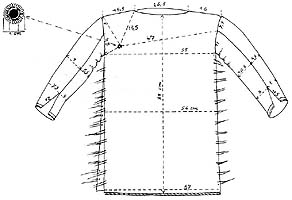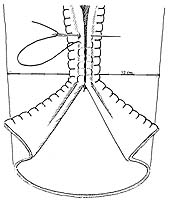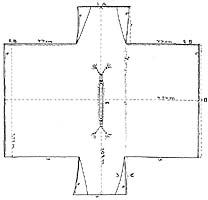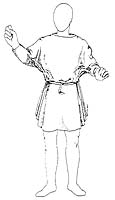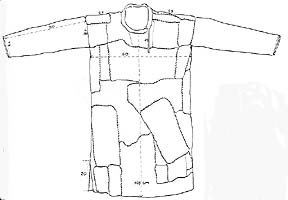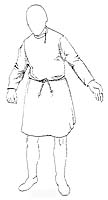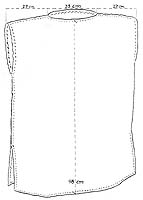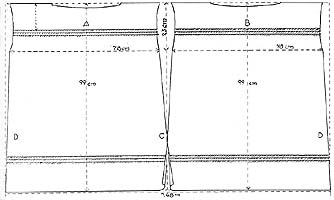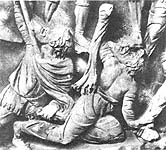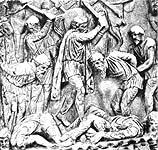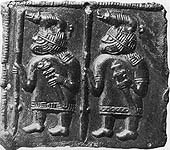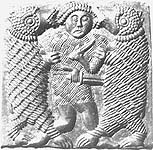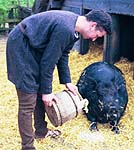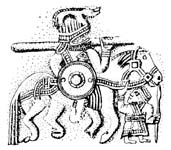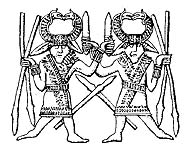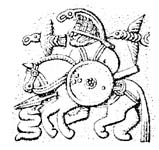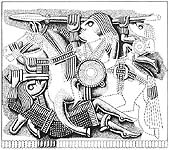 |
||||||||||||||||||||||||||||||||||
|
Lesson #4: Page 4
These tunics usually reach somewhere between the upper thigh to a few inches above the knee. Frankish men seem to have worn a knee length tunic, and this type of garment may also have been worn in England, particularly in Kent with its strong Frankish links. #2 On the excavated examples these sleeves are usually long enough to be folded back in to a cuff (as on some Celtic tunics) or pushed back from the wrist in folds (as in later Anglo-Saxon examples). The last few inches of the sleeve seams were sometimes left open at the wrist to allow the hands to pass through (there are no examples of wrist clasps from male graves, so the slits may have been closed by tying, sewing, or just left open). Some of these tunics also have the last few inches of the side seam left unjoined, to allow for easier movement. In these cases the back is often a few centimeters longer than the front. The neck openings on these early tunics were usually just slits or oval openings. Tunics seem to come in two basic types, tight fitting and loose. The famous tunic from Thorsberg is of the tighter type, as is the tunic from Bernuthsfeld. #3 As the Thorsberg tunic is the best known and best preserved, and it dates from the Migration Period I will describe it here. It is well preserved and must have been an exceptionally fine and carefully made garment. The tunic consists of four pieces of fine woollen twill cloth, and has two ornamental tablet-woven bands at the lower edges of the sleeves. The front piece is 86cm long and the back piece 90cm; it is 56cm wide. The neck opening is about 3-3.5cm deeper in front than behind, and about 26cm long across the shoulders, although the latter is not absolutely clear due to damage. The sleeves are taken across the loom, thus ensuring a maximum utilisation of the narrow cloth, the loom width constitutes the width of the garment and the length of the sleeves, demonstrated by selvedges at the armhole and wrist. The sleeves are slightly shaped by folding the material so that a slight curve is formed at the top of the sleeve, the seam of which meets the back piece c. 7cm below the shoulder seam. The sleeves are not shaped by cutting, instead their width is maintained to a little way beyond the elbow, after which the material is taken in and seamed so at the wrists the measurement has decreased to 18cm. An unusual feature of the Thorsberg tunic is that the side seams are not closed by sewing, but by a series of ties. It is probable, in light of the other surviving tunics and other textile evidence, that sewing the side seams together was more usual. Click on image for a larger version in a new window Another tunic, from Reepsholt in Frisia, is much larger and baggier, hanging in many folds when worn, as is seen in some pictorial representations. Although possibly unusual in its weaving, #4 this shape of garment can easily be constructed in the same manner as the Thorsberg garment, though with different dimensions. A slit was left at the bottom of each side seam to allow greater freedom of movement. Like the Thorsberg tunic, the shaping in the sleeves was done by sewing rather than cutting. There were no gores in the tunic, so it was not tailored, although the neck opening was reinforced with tablet woven cord. The weaving and wool used suggest it was manufactured in Northern Europe and was not an import. Click on image for a larger version in a new window One thing that is remarkably consistent is the length of the surviving tunics, which are all around 1m long. The widths are more variable of course given the fact that both tight and loose tunics seem to have been in use. The dimensions are useful as the average height of an Anglo-Saxon man was approximately the same as a modern man. The table below shows the dimensions
of surviving tunics.
Click on image for a larger version in a new window Tunics were often decorated with tablet woven borders at the neck, cuffs and hem. Decorative stitching was also used, but the ornate decoration of tunics with appliqué or woven stripes (clavi) and coloured patches like those of the late Roman type appears not to have been used. Tunics at this time appear to have been known by the names cyrtel (probably the shorter type of tunic) and pad. Click on image for a larger version in a new window The Elusive Jacket
They are usually knee length with long sleeves. Their origin is unclear, but they may be related to the open fronted robes worn by Frankish women, or they could be related to the kaftan type jackets worn by some of the steppes nomads. How widely they were worn, and if they had any special significance is unclear, although most seem to be worn by warriors. Archaeology hints at their existence with the remains of a sixth century garment from Hogom in Scandinavia tentiatively identified as a jacket of this type. An early seventh century burial in Cologne in Germany preserved the remains of a gold brocaded tablet weave running around a male skeleton's neck down to below his waist in a manner similar to the decoration shown on these jackets. A later (9th or 10th century) fragment from Hedeby may also belong to part of a jacket of this type. Unfortunately we cannot tell for certain if this garment made up part of the Anglo-Saxon wardrobe, but we can tentatively reconstruct it. It would seem to be a fine woollen garment, knee length which wraps around the body and overlaps. It is long sleeved, with either broad bands of tablet weave or decorative stitching all the way around the edge and the cuffs. Whether it would be worn over the tunic, or in place of it is uncertain. Click on image for a larger version in a new window
1 The surviving examples are likely to be somewhat earlier than the period of study (the Obenaltendorf tunic is dated to about 200AD), but sculptures such as the Marcus Column show their use continued into the Migration Period. back 2 Knee length tunics became the standard after the conversion to Christianity, and seem to have formed an important element of 'Christian dress'. The extent to which these tunics would have been worn by Pagan Aanglo-Saxons is not known. back 3 The Bernuthsfeld tunic is a mysterious garment with similarities to both migration period garments and an 11th century shirt from Viborg. It seems to be made entirely from patches and scraps of fabric, although the reason for this is unclear. However, it is generally similar in cut to the Thorsberg tunic. back 4 This tunic was woven to shape on the loom, a technique otherwise unknown in Northern Europe. Despite its unusual manufacture, its shape fits in well with what we know from pictorial representations and the shape could easily be made by sewing on seperate sleeves, rather than weaving them, making a garment that consists only of rectangles of cloth. back
|
||||||||||||||||||||||||||||||||||
| Costume
Classroom is a division of The
Costume Gallery, copyright 1997-2002.
Having problems with this webpage contact: questions@costumegallery.com |
||||||||||||||||||||||||||||||||||
